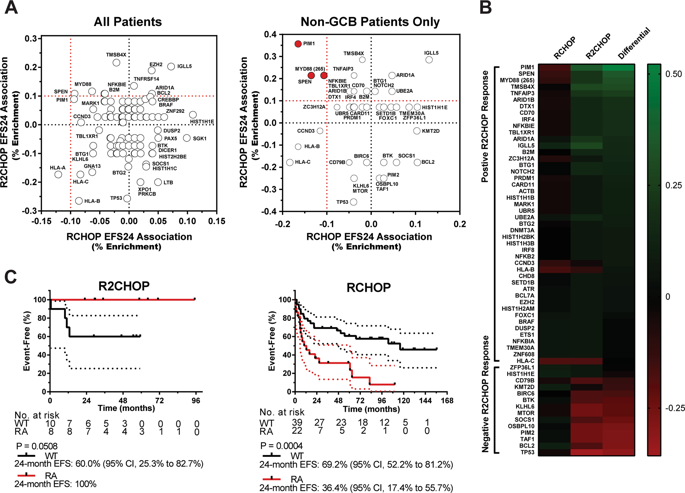Leukemia ( IF 12.8 ) Pub Date : 2020-03-05 , DOI: 10.1038/s41375-020-0766-4 Keenan T Hartert 1 , Kerstin Wenzl 1 , Jordan E Krull 1 , Michelle Manske 1 , Vivekananda Sarangi 2 , Yan Asmann 3 , Melissa C Larson 2 , Matthew J Maurer 2 , Susan Slager 2 , William R Macon 4 , Rebecca L King 4 , Andrew L Feldman 4 , Anita K Gandhi 5 , Brian K Link 6 , Thomas M Habermann 1 , Zhi-Zhang Yang 1 , Stephen M Ansell 1 , James R Cerhan 2 , Thomas E Witzig 1 , Grzegorz S Nowakowski 1 , Anne J Novak 1

|
Diffuse large B-cell lymphoma (DLBCL) is the most common lymphoma, and front line therapies have not improved overall outcomes since the advent of immunochemotherapy. By pairing DNA and gene expression data with clinical response data, we identified a high-risk subset of non-GCB DLBCL patients characterized by genomic alterations and expression signatures capable of sustaining an inflammatory environment. These mutational alterations (PIM1, SPEN, and MYD88 [L265P]) and expression signatures (NF-κB, IRF4, and JAK-STAT engagement) were associated with proliferative signaling, and were found to be enriched in patients treated with RCHOP that experienced unfavorable outcomes. However, patients with these high-risk mutations had more favorable outcomes when the immunomodulatory agent lenalidomide was added to RCHOP (R2CHOP). We are the first to report the genomic validation of a high-risk phenotype with a preferential response towards R2CHOP therapy in non-GCB DLBCL patients. These conclusions could be translated to a clinical setting to identify the ~38% of non-GCB patients that could be considered high-risk, and would benefit from alternative therapies to standard RCHOP based on personalized genomic data.
中文翻译:

R2CHOP 在高危 DLBCL 中靶向炎症通路。
弥漫性大 B 细胞淋巴瘤 (DLBCL) 是最常见的淋巴瘤,自免疫化疗出现以来,一线治疗并未改善总体预后。通过将 DNA 和基因表达数据与临床反应数据配对,我们确定了非 GCB DLBCL 患者的高风险子集,其特征是基因组改变和能够维持炎症环境的表达特征。这些突变改变(PIM1、SPEN和MYD88 [L265P])和表达特征(NF-κB、IRF4 和 JAK-STAT 参与)与增殖信号传导相关,并且发现在接受 RCHOP 治疗且经历不利的患者中丰富。结果。然而,当免疫调节剂来那度胺添加到 RCHOP (R2CHOP) 中时,具有这些高风险突变的患者获得了更有利的结果。我们是第一个报告非 GCB DLBCL 患者对 R2CHOP 治疗有优先反应的高风险表型的基因组验证。这些结论可以转化为临床环境,以确定约 38% 的非 GCB 患者可被视为高风险,并将受益于基于个性化基因组数据的标准 RCHOP 的替代疗法。









































 京公网安备 11010802027423号
京公网安备 11010802027423号